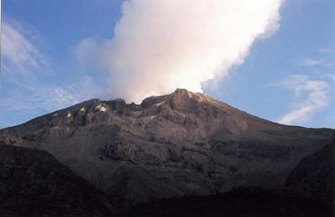Friday Fungoes
Did a volcano in China cause the great Permian extinction? Maybe. Maybe not. We do know that a giant new undersea volcano was found off Indonesia and volcanoes continue to rumble worldwide. UPDATED!
Here’s some news bits for all you volcanophiles. Enjoy the weekend!
nn

nUbinas in Peru steaming away in June 2007. Image courtesy of Eruptions reader Mike Lyvers.
nn
- n
- There has been a lot of press lately on the theory that a large eruption from an ancient volcanic field in China (the 260-million-year-old Emeishan volcanic province of southwest China) could be the culprit in the grand Permian extinction. I have to admit, I’ve only skimmed the surface of this study, but the work lead by Dr. Paul Wignall (a paleontologist, not a volcanologist – not that there is anything wrong with that) seems to center around the amount of sulfur dioxide released in this 500,000 km3 basaltic eruption. Now some of the articles seem to be a bit confused about the science, such as attributing the sulfur dioxide to lava flows interacting with water, I think based on a comment by Dr. Wignall that a lot of steam might be produced as lava interacts with water. Of course, we can already discount the coverage in the UK venerable Sun, who titled their article on the study “Eruption was a hel-lava blast” – with an accompanying picture of a random, unrelated volcano (and the link to this on my RSS feed was called “Eruption nearly wiped out planet” … ah, the Sun!)nReally, I think the big news in this study was the ability to precisely date the eruption relative to the extinction using radiometric data and fossil stratigraphy – however, I’m not sure if the “correlation = causation” has been fully justified yet.
- In a little less ancient news, there has been increased seismicity (in spanish) around Nevado del Huila in Colombia. This week there were at least 25 earthquakes, some as high as M4.8 (in spanish) at ~8.5 km depth (in spanish). They caused some (in spanish) minor damage, landslides and injuries in the area (municipality of Belalcázar) near the active volcano. INGEOMINAS has kept the alert status at Huila at Yellow (Watch), although there was apparently some discussion of raising it to Orange. Huila has been building a new dome since last year at the summit and these earthquakes could herald new magma moving into the edifice from depth.
- I had mentioned some activity at Ubinas in Peru earlier this week, but authorities in that South American country are playing down the threat. The ash and volcanic gases don’t appear to be pointing towards a major eruption say scientists from the Instituto Geofísico Minero Metalúrgico de Moquegua.n
- Eruptions reader David pointed out that Anak Krakatau is experiencing heightened activity to the point that officials have closed off a 3-km area around the volcano to fishermen and tourists. The volcano has had increased seismic activity along with a number of vulcanian explosions over the last few weeks.
- Finally, there was a brief piece about a fairly significant undersea volcano that was found during a seafloor survey of the Sunda Trench (also known as the Java Trench). This volcanic edifice rises 4,600 meters / 15,000 feet (!) off the ocean floor and has a 50 km / 31 mile circumference. The edifice is located off the coast of the
islandcity of Bengkulu. As for its age and potential threat, it is unknown how old the deposits on the volcano are, but as team scientist Yusuf Surachman notes “an underwater volcano is very dangerous if it erupts.” Well put … especially if it as big as this one appears. UPDATE 5/29/09 9:30AM: OK, this is just weird. It seems like someone, somewhere, is interpreting this discovery as a “new volcano” that sprung up overnight. This is not how I read the initial article – heck, this could be an extinct seamount for all we know right now. Not sure why they are so voraciously denying this beyond worry of panic … any thoughts?
n
n
n
n




